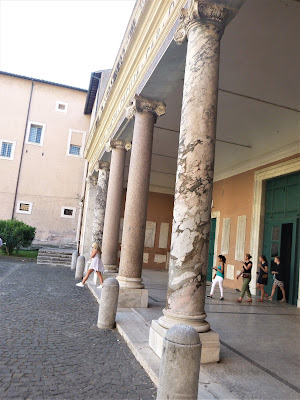Trastevere was once the most populous district of Imperial Rome. Being across the Tiber River (hence the name Trastevere) it went into quite a decline in the Dark Ages. The churches however persisted, and it is the ecclesiastical records that shed much of the Light into that era. In modern times Trastevere is abuzz with a milling herd of tourists, at least in the area north of Viale Trastevere. Go a ways south, down where Santa Cecelia lies, and you will leave them behind.
It's a pretty spot. Unlike San Christogono it still has its own garden like Piazza out front. The columns are of course ancient, borrowed from an unknown site. They are a matched set, two from quarries in Aswan Egypt, and two from Turkey.
The entrance to the archaeological excavations was easy to find, and an efficient looking nun was stationed there to accept our small entry fee.
Down below is the usual jumble of features and eras. Here is a monochrome mosaic floor of Severan vintage.
Pretty much every Italian archaeological site has something like this. A little barred off room for random things they found on their dig. I figure all the official museums in Italy are already full up. These remind me of Old West jail cells.
Here we see several odd holes in the floor. At one point they were considered to be evidence of a tannery on site but the stonework does not show the corrosion associated with harsh chemicals. So probably food storage silos.
They don't even look a little like baptismal fonts but people still toss down votive offerings in the form of coins.
Right in the middle of the dim ancient walls you walk into this brilliantly lit room. It holds the relics of Saint Cecelia. Maybe.
Sigh. OK, lets talk about Saint Cecelia. The Catholic church admits that her story is probably fiction. You be the judge.
Supposedly she was a noble woman who secretly converted to Christianity and simultaneously took a vow of chastity. That did not stop her parents from marrying her off to a pagan chap named Valerian. With some (much needed?) help from her guardian angel the situation was squared with her new husband who agreed to also convert. Valerian, his brother, and a soldier who converted while guarding them...all got put to death. As did Cecelia. Eventually.
First she was locked in the hot room of her own bath house for a few days. That did not work. Then they tried to cut off her head but somehow botched the job albeit while injuring her somewhat such that she died three days later.
After initial internment in one of the catacombs her remains - found of course to be incorruptible - were returned to the church that had been built at the site of her house.
Behind the screen are sarcophagi holding the remains of Cecelia and the other players in this bit of saintly drama. Including her extremely understanding husband Valerian who in my book earned his sainthood at least as much as Cecelia.








No comments:
Post a Comment